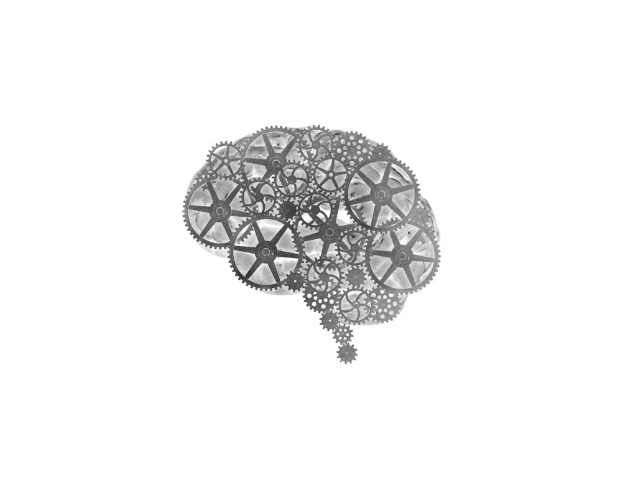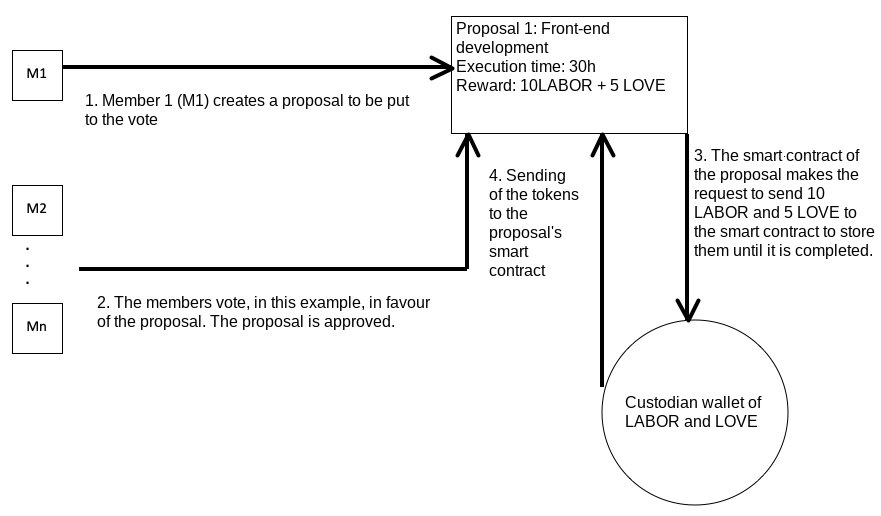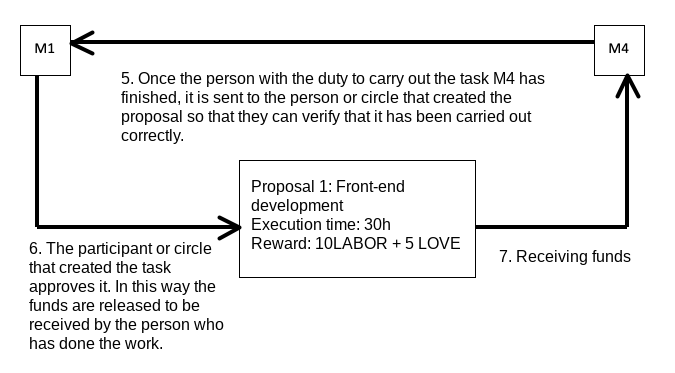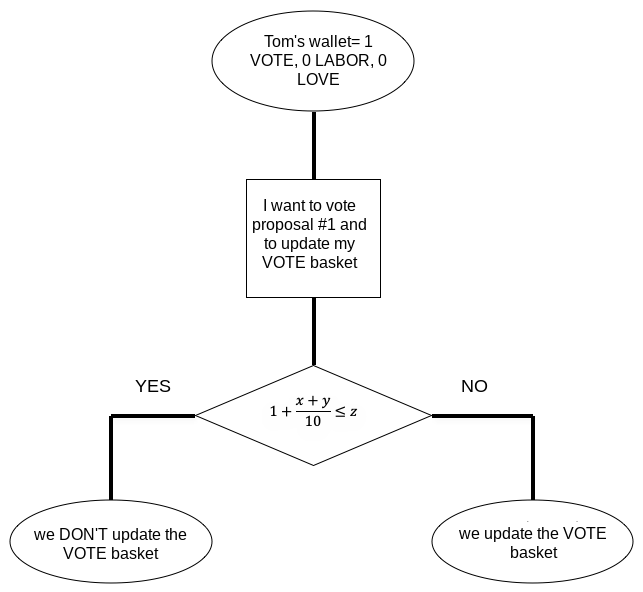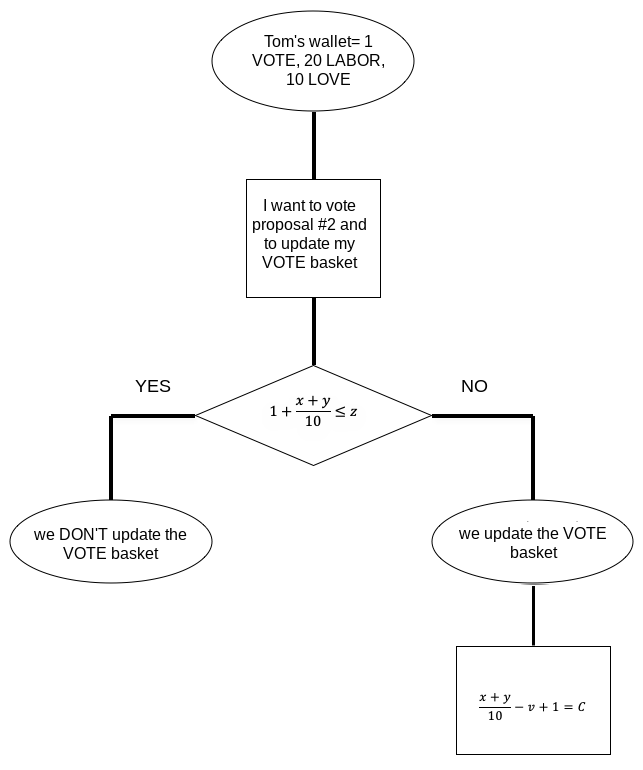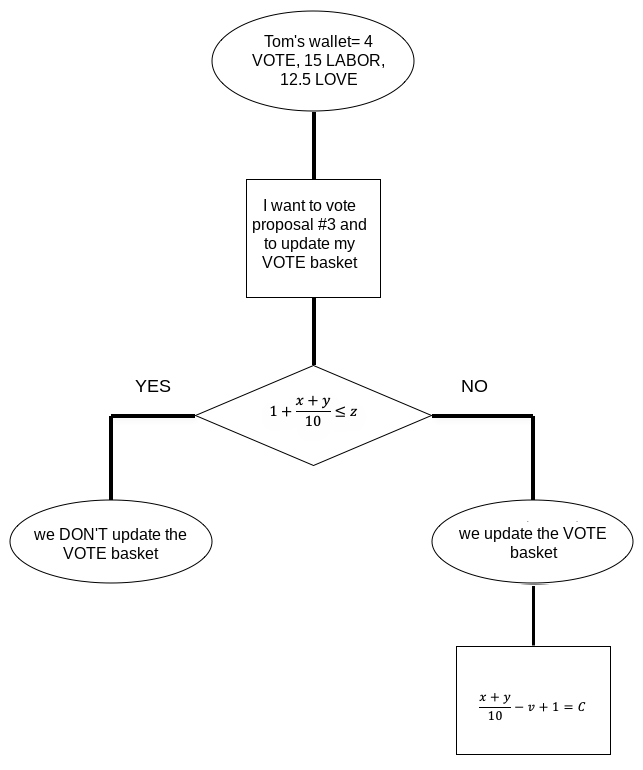Technical introduction to Holistic Weighting of Vote Protocol with reputation and mutual credit tokens.
Tokenomics for DAO Gobernance and CES Exchange
v1.0
(under development)
Our DAO governance and community exchange system (CES) of the decentralized cooperative (DC) Ecofintech Coop works with 3 native cryptographic tokens called LABOR, LOVE and VOTE. These three tokens each have a specific function within the ecosystem.
LABOR Token
The Labor–value Token (LABOR) is a token based on the RRC-20 standard on the RSK federated network. This token is transferable and interchangeable between the members of the decentralised cooperative, so that it can be freely obtained at an exchange and traded with other members as well as received as a form of payment for work carried out. When performing a task of, for example, developing a front end or training a new participant, a quantity of LABOR will be obtained and at the same time a quantity of LOVE (care work) based on the amount of LABOR, in a relationship:
1 LABOR = 0,5 LOVE
The amount of LABOR received for the jobs in relation to the time spent is 3h = 1 LABOR.
As we see producing value through work it also generates a part of care work for the cooperative, which is accounted for using the non-transferable LOVE reputation token.
Website: https://labor-token.github.io/
LOVE Token
Unlike LABOR, it is not interchangeable between members and cannot be bought or sold. The only way for a member to obtain the LOVE token is by being recognized in their contribution in care or by generating LABOR, while at the same time obtaining a part of LOVE. This token will not be received through the purchase and sale of LABOR, since it only corresponds to a reputation granted and withdrawn by the community to each specific participant. The mechanism of acquisition of LOVE and the subsequent calculation of VOTE avoid the risk of losing governance rights to external investors, so that the workers of the cooperative will always be able to balance in their favor most of the decision-making power.
The community of participants in the DC may assign (to mint) or remove (to burn) LOVE to other members, whether or not they have required it. In this way the care and reproductive work token is established as a reputable token with meritocracy function for participants.
VOTE Token
This token allows DC members to participate in the voting of proposals made. VOTE will be accumulated over time as a basket, therefore, the members who contribute more to the community, either in the form of work or making other contributions, and have acquired more LABOR & LOVE will have more influence on the votes.
For starters, members who are approved in the DC, will have 1 VOTE and from that initial amount they will be able to acquire more VOTE that will accumulate over time, thanks to the profit of LABOR & LOVE.
Holistic Weighting of Vote Protocol: (in R&D process)
From the platform cooperativism and the open value networks we understand by a consensus model just the one that visualizes a greater influence in the decision making to the members that contribute more in work and care of the project. By means of the vote with holistic weighting factor designed by Ecofintech Coop, each participant in the ecosystem has a weight of vote calculated through the history of the work and care credits contributed in an integral way to the ecosystem and accounted for by means of the cryptographic cards that we have described previously.
Now let’s see how the three components interact with each other, and what role each plays within the functioning and governance of the DC. In order to do this, we are going to define the basic elements that must compose the system, these will be: members and proposals.
-
Members: are the members of the DC, charged with voting on proposals to be rejected or carried out. They carry out the different development and administration tasks and in this way obtain LABOR and LOVE tokens as a reward for their work. In this way they obtain additional VOTE to be members of more weight within the network according to their work or care provided. They can sell in the market or redeem with the own DC the obtained LABOR and thus to obtain a retribution in cash or cryptocurrency.
-
Proposals: These are a fundamental part of the DC ecosystem. Thanks to the proposals, progress in the organization is achieved and the different actions are promoted. The idea is that the proposals are a smart contract that interacts with the members and the wallet that keeps the LABOR and the LOVE in the following way:
In the first instance, the proposal is created to be put to a vote(1), the member who creates it allocates the time that he considers convenient for the completion of the task, which will lead to a reward based on that time in LABOR and its correspondent LOVE, and which will be taken from the DC fund. It can also be proposed by a private individual with their own funds in LABOR, fostering the internal economy of the cooperative. The next step (2) will be to vote for or against it to allow its execution. Once approved (3), the Smart contract of the proposal, requests the funds to the custodian wallet to store them until the task is executed and verified. Finally, the wallet custodian sends the amount to the smart contract(4). (note: we will modify this point so that instead of a wallet custodian, the tokens are coined directly by the contract).
Now we move on to the part where the task is performed, and tokens are sent from the Smart contract of the proposal to the member who has done the work.
This type of proposal is a subsistence work. There are also proposals that are just consultations for decision making, movements of funds for some external project, etc., and requests for remuneration for commons oriented work carried out autonomously.
Assignment of VOTE tokens: They are those that allow to interact with the proposals.
When voting on proposals, the VOTE basket must be updated so that, if someone has won LABOR or LOVE, this holistic increase in influence is reflected in the basket.
The way in which this process is carried out is through the application and evaluation of the following formula:
1.- Formula to know if the wallet has received new tokens and must update the basket (this way it is avoided that a malicious user, acquiring LABOR in market and adding one to one each token, adds VOTE over the limit that corresponds to him):
x: Amount of LABOR contained in the user’s wallet
y: Amount of LOVE contained in the user’s wallet
z: Amount of VOTE contained in the user’s wallet
2.- Once it is calculated, in case of result not equal or less, the basket must be updated before a new voting proposal, the following formula is applied to add VOTE:
C: Amount of VOTE to be added to the wallet
The application of this formula within the voting process will be shown through an example in which a member of the DC, Tom, enters the same, is approved by the community and therefore receives their respective VOTE token to interact in the organization and from there, interact with the different proposals.
What we are looking for is a method to prevent a malicious agent from getting indefinitely VOTE, making votes over and over again so that your basket is updated and receive the tokens without it having obtained more LABOR or LOVE. As we mentioned earlier, the example starts with member 1, which we will call Tom, joining the DC, being approved and receiving his 1st VOTE token so that he can immediately start taking sides in the organization’s processes. This member wants to vote on proposal #1, and the next voting process is triggered, but first the VOTE basket has to be updated. So that the system does not allow VOTES to be won without new LABOR & LOVE having been achieved. The first formula is applied, where x=0, y=0 and z=1, which would result in a result of 1 = 1. When evaluating it, the check that we have not received tokens would be fulfilled, therefore, the VOTE basket would not have to be updated.
Following this example, time passes and Tom has done some work for the DC and obtained some tokens, 20 LABOR and 10 LOVE, since then he has not wanted to vote, as no proposal has caught his attention or he has simply not been able to participate (in this case the decentralised cooperative would continue to function despite situations of low participation, thanks to the Holographic Consensus protocol, see below). Then a proposal appears in which he wishes to take part. This is where the previous process takes place again, but with a difference at the end of it:
In this process, Tom will vote on proposal #2, so like the previous time with proposal 1, he must first update his VOTE basket. We apply the formula again and evaluate it, this time we have to x=20, y=10 and z=1. This time the equality is not fulfilled, since 4 is neither less nor equal to 1, which means that we have received LABOR and LOVE that has not been taken into account in our VOTE basket and therefore we have to update and receive the VOTE that correspond to us. The way to know how much VOTE has to be added to the wallet, is by applying the second formula.
This formula allows to take into consideration only the tokens added since the last update and exceeding the historical maximum. It also gives us the possibility to avoid that a malicious agent can acquire additional VOTE thanks to the purchase of LABOR in an exchange to pass it of 1 in 1 to his wallet and to make votes in different iterations to go accumulating VOTE, taking into account all the historical tokens instead of only the last added, of this form it would surpass the historical maximum. This mechanism also allows that when someone has won a number of tokens, then has received their VOTE, then has spent the LABOR tokens and lost LOVE; and then has won more LABOR and LOVE, these tokens that have been won will not be taken into account until the member accumulates as many as the last time his basket was updated. In this example, we have calculated that C=3, this amount will be added to our wallet and we can now vote. Leaving Tom with 20 LABOR, 10 LOVE AND 4 VOTE. If Tom spends 10 LABOR and then wins 5 LABOR and 2.5 LOVE he will have in his wallet 15 LABOR, 12.5 LOVE and 4 VOTE, applying the formula, therefore, his basket will not be updated even if new tokens have been entered. As you have not stored enough, the VOTE increase will not occur until the equation exceeds the number of 4 VOTES. This system will make historical accumulation increasingly difficult for members and thus avoid monopoly on voting.
We continue with the example and now Tom spends 10 LABOR and then wins 5 LABOR and 2.5 LOVE, then wants to vote a third proposal. As before, we evaluate with the formula and in this case we have to x=15, y=12.5 and z=4, leaving the equality. As 3.75 is less than 4, equality is fulfilled and we do not update the VOTE basket.
The same process can be applied if, after voting on this proposal, Tom would like to vote on a fourth proposal just after the third. Since there would be no changes to his wallet, the process would be identical.
Holographic Consensus:
This protocol designed by DAOstack allows us greater resilience and scalability in the decision-making process, establishing mechanisms that reward attention and allowing a democratic confederated decision-making model more efficient than the flat assembly. Participants can structure voting by delegating in sections by topic or specialization, and proposals are not blocked in situations of low participation.
Tokenómica de gobernanza DAO e intercambio CES
v1.0
(en desarrollo)
Nuestro sistema de gobernanza DAO (decentralised autonomous organization) y sistema de intercambio comunitario (CES, community exchange system) de la cooperativa descentralizada (DC) Ecofintech Coop funciona con 3 fichas criptográficas o tokens nativos llamados LABOR, LOVE y VOTE. Estos tres tokens tienen cada uno una función determinada dentro del ecosistema.
Token LABOR
El Token de Valor-trabajo (LABOR) es un token basado en el estándar RRC-20 sobre la red federada RSK. Éste token es transferible e intercambiable entre los miembros de la cooperativa descentralizada, por lo que se podrá obtener libremente en una casa de cambio e intercambiarse con otros miembros así como recibirla como forma de pago por trabajos realizados. Al realizar una tarea de, por ejemplo, desarrollo de un front end o acompañamiento de una nueva participante, se obtendrá una cantidad de LABOR y a la vez una cantidad de LOVE (trabajo de cuidados) basada en el monto de LABOR, en una relación:
1 LABOR = 0,5 LOVE
La cantidad de LABOR que se recibe por los trabajos en relación al tiempo empleado es de 3h = 1 LABOR.
Como vemos producir valor mediante trabajo también genera una parte de trabajo de cuidados para la cooperativa, el cual es contabilizado usando el token no transferible de reputación LOVE.
Página web: https://labor-token.github.io/
Token LOVE
A diferencia de LABOR, éste no es intercambiable entre miembros y tampoco se puede comprar o vender. La única forma de que un miembro obtenga el token LOVE, es siendo reconocida en su aportación en cuidados o bien a base de generar LABOR, obteniendo al mismo tiempo una parte de LOVE. No se recibirá este token mediante la compra-venta de LABOR, pues corresponde únicamente a una reputación otorgada y retirada por la comunidad a cada participante en concreto. El mecanismo de adquisición de LOVE y el subsiguiente cálculo de VOTE evitan el riesgo de perder derechos de gobernanza ante inversores externos, de tal forma que siempre los y las trabajadoras de la cooperativa van a poder balancear a su favor la mayor parte de poder de decisión.
La comunidad de participantes en la DC podrá asignar (acuñar) o retirar (quemar) LOVE a otros miembros, lo hayan requerido éstos o no. De ésta forma el token de cuidados y trabajo reproductivo se establece como un token de reputación con función de meritocracia para participantes.
Token VOTE
Este token, permite la participación de los miembros de la DC para las votaciones de las propuestas realizadas. VOTE será acumulado en el tiempo a modo de cesta, por tanto, los miembros que más aporten a la comunidad, ya sea en forma de trabajo o realizando otras aportaciones, y han adquirido más LABOR & LOVE tendrán más influencia en las votaciones.
De entrada, los miembros que sean aprobados en la DC, tendrán 1 VOTE y a partir de esa cantidad inicial podrán adquirir más VOTE que se irá acumulando en el tiempo, gracias a la ganancia de LABOR & LOVE.
Protocolo Holístico de Ponderación de Voto: (en proceso R&D)
Desde el cooperativismo de plataforma y las redes de valor abierto entendemos por un modelo de consenso justo aquél que visualiza una mayor influencia en la toma de decisión a los miembros que más contribuyen en trabajo y cuidado del proyecto. Mediante el voto con factor de ponderación holística diseñado por Ecofintech Coop, cada participante en el ecosistema cuenta con un peso de decisión calculado mediante el histórico de los créditos de trabajo y cuidado aportados de forma integral al ecosistema y contabilizados mediante las fichas criptográficas que hemos descrito anteriormente.
Ahora vamos a ver como los tres componentes interactúan entre sí, y qué papel juega cada uno dentro del funcionamiento y gobernanza de la cooperativa descentralizada. Para ello, vamos a definir los elementos básicos que deben componer el sistema, estos serán: miembros y propuestas.
-
Miembros: son los integrantes de la DC, encargados de votar las propuestas para que sean rechazadas o llevadas a cabo. Realizan las diferentes tareas de desarrollo y administración y de ésta forma obtienen tokens LABOR y LOVE como recompensa a su labor. Así obtienen VOTE adicional para ser miembros de más peso dentro de la red según su trabajo o cuidados aportado. Pueden vender en el mercado o redimir con la propia DC los LABOR obtenidos y así obtener una retribución en efectivo o criptomonedas.
-
Propuestas: éstas son una parte fundamental del ecosistema DC. Gracias a las propuestas se logra el avance en la organización y se van promoviendo las diferentes acciones. La idea es que las propuestas sean un smart contract que interactúe con los miembros y el wallet o monedero que custodia el LABOR y el LOVE de la siguiente forma:
En primera instancia, se crea la propuesta para ser sometida a votación(1), el miembro que la crea, asigna el tiempo que cree conveniente para la realización de la tarea lo que conllevará a una recompensa en función de ese tiempo en LABOR y su correspondiente LOVE, y que se sacará del fondo de la DC. También puede ser propuesta por un particular con sus propios fondos en LABOR, fomentando la economía interna de la cooperativa. El siguiente paso(2), será realizar la votación ya sea a favor o en contra de la misma para permitir su ejecución. Una vez aprobada (3), el Smart contract de la propuesta, pide los fondos al wallet custodio para almacenarlos hasta que la tarea sea ejecutada y verificada. Finalmente, el wallet custodio envía el monto al smart contract(4). (nota: modificaremos éste punto para que en lugar de un wallet custodio, los tokens sean acuñados directamente por el contrato).
Ahora pasamos a la parte en la que la tarea se realiza, y se hace el envío de tokens desde el Smart contract de la propuesta hacia el miembro que ha realizado el trabajo.
Este tipo de propuesta es del tipo tarea de subsistencia. También existen propuestas que son tan sólo consultas para la toma de decisiones, movimientos de fondos para algún proyecto externo, etc, y peticiones de retribución por tareas pro-común llevadas a cabo de forma autónoma.
Asignación de tokens VOTE: Son aquellos que permiten interactuar con las propuestas.
A la hora de realizar las votaciones de las propuestas, se debe actualizar la cesta de VOTE para que de ésta forma, si alguien ha ganado LABOR o LOVE, éste aumento holístico de influencia se vea reflejado en la cesta.
La forma en la que se lleva a cabo este proceso, es mediante la aplicación y evaluación de la siguiente formula:
1.- Fórmula para conocer si el wallet ha recibido nuevos tokens y debe actualizar la cesta (de ésta forma se evita que un usuario malicioso, adquiriendo LABOR en mercado y sumando uno a uno cada token, añada VOTE por encima del límite que le corresponde):
x: Cantidad de LABOR que contiene el wallet del usuario
y: Cantidad de LOVE que contiene el wallet del usuario
z: Cantidad de VOTE que contiene el wallet del usuario
2.- Una vez es calculado, en caso de resultado no igual o menor, se debe actualizar la cesta ante una nueva propuesta de votación, se aplica la siguiente fórmula para añadir VOTE:
C: Cantidad de VOTE que se añadirá a la wallet
La aplicación de esta fórmula dentro del proceso de votación la mostraremos a través de un ejemplo en el que un miembro de la DC, Tom, ingresa a la misma, es aprobado por la comunidad y por tanto recibe su respectivo token VOTE para interactuar en la organización y partir de ahí, interactuar con las diferentes propuestas.
Lo que estamos buscando es un método para evitar que un agente malicioso pueda obtener de manera indefinida VOTE, realizando votaciones una y otra vez para que su cesta se actualice y recibir los tokens sin que éste haya obtenido más LABOR o LOVE. Como mencionamos anteriormente, el ejemplo comienza con el miembro 1, al que llamaremos Tom, uniéndose a la la DC, siendo aprobado y recibiendo su token VOTE para que pueda empezar a tomar partido inmediatamente en los procesos de la organización. Dicho miembro quiere votar la propuesta 1, y se desencadena el siguiente proceso de votación, pero primero se ha de actualizar la cesta de VOTE. Para que el sistema no permita que se ganen VOTEs sin que se hayan conseguido LABOR & LOVE nuevos, se aplica la primera fórmula, donde x=0, y=0 y z=1, lo que daría lugar a un resulta de 1 = 1. Al evaluarla, se cumpliría la comprobación de que no hemos recibido tokens por lo tanto, la cesta de VOTE no se ha de actualizar.
Siguiendo con el ejemplo, pasa el tiempo y Tom ha realizado algunos trabajos para la DC y ha obtenido algunos tokens, 20 LABOR y 10 LOVE, desde entonces no ha querido realizar votaciones, ya que ninguna propuesta ha llamado su atención o simplemente no ha podido participar (en éste caso la cooperativa descentralizada seguiría con su funcionamiento a pesar de situaciones de baja participación, gracias al protocolo de Consenso Holográfico, ver más adelante). Entonces aparece una propuesta en la que desea tomar parte. Es aquí donde vuelve a tener lugar el proceso anterior, pero con una diferencia al final del mismo:
En este proceso, Tom va a votar la propuesta 2, entonces al igual que la vez anterior con la propuesta 1, primero se debe actualizar su cesta de VOTE. Aplicamos de nuevo la fórmula y la evaluamos, esta vez tenemos que x=20, y=10 y z=1. Esta vez la igualdad no se cumple, ya que 4 no es menor ni igual a 1, lo que quiere decir que hemos recibido LABOR y LOVE que no se ha tenido en cuenta en nuestra cesta de VOTE y por tanto hemos de actualizar y recibir los VOTE que nos correspondan. La manera de saber cuanto VOTE se ha de sumar al wallet, es mediante la aplicación de la segunda fórmula.
Ésta fórmula permite tener en consideración sólamente los tokens añadidos desde la última actualización y superando el máximo histórico que se ha tenido. También nos da la posibilidad de evitar que un agente malicioso pueda adquirir VOTE adicional gracias a la compra de LABOR en un exchange para pasarlo de 1 en 1 a su wallet y realizar votaciones en distintas iteraciones para ir acumulando VOTE, teniendo en cuenta todos los tokens históricos en lugar de sólo los últimos añadidos, de ésta forma superaría el máximo histórico. Este mecanismo también permite que cuando alguien ha ganado una cantidad de tokens, posteriormente ha recibido sus VOTE, luego a gastado los tokens LABOR y perdido LOVE; y después ha ganado más LABOR y LOVE, estos tokens que se han ganado no se tendrán en cuenta hasta que el miembro acumule tantos como la última vez que se actualizó su cesta. En este ejemplo, hemos calculado que C=3, esta cantidad se añadirá a nuestra wallet y ya podemos realizar la votación. Quedando Tom con 20 LABOR, 10 LOVE Y 4 VOTE. Si Tom gasta 10 LABOR y luego gana 5 LABOR y 2.5 LOVE tendrá en su wallet 15 LABOR, 12.5 LOVE y 4 VOTE, aplicando la formula, por tanto, no se actualizará su cesta aunque hayan entrado nuevos tokens. Como no ha almacenado los suficientes, no se producirá el aumento de VOTE hasta que la ecuación supere el número de 4 VOTES. Este sistema conseguirá que la acumulación histórica cada vez sea más difícil para los miembros y de ésta forma evitará el monopolio sobre las votaciones.
Seguimos con el ejemplo y ahora Tom gasta 10 LABOR y luego gana 5 LABOR y 2.5 LOVE, después quiere votar una tercera propuesta. Igual que anteriormente, evaluamos con la fórmula y en éste caso tenemos que x=15, y=12.5 y z=4, quedando la igualdad. Como 3.75 es menor que 4, la igualdad se cumple y no actualizamos la cesta de VOTE.
Se puede aplicar el mismo proceso si después de votar esta propuesta, Tom quisiera votar una cuarta propuesta justo después de la tercera. Como no habría cambios en su wallet, el proceso seria idéntico.
Consenso Holográfico:
Éste protocolo diseñado por DAOstack nos permite mayor resiliencia y escalabilidad en el proceso de toma de decisiones, estableciendo mecanismos que recompensen la atención y permitiendo un modelo confederal de toma de decisiones más eficiente que la asamblea plana. Las participantes pueden estructurar la votación delegando en secciones por temáticas o especialización, y las propuestas no quedan bloqueadas en situaciones de baja participación.
